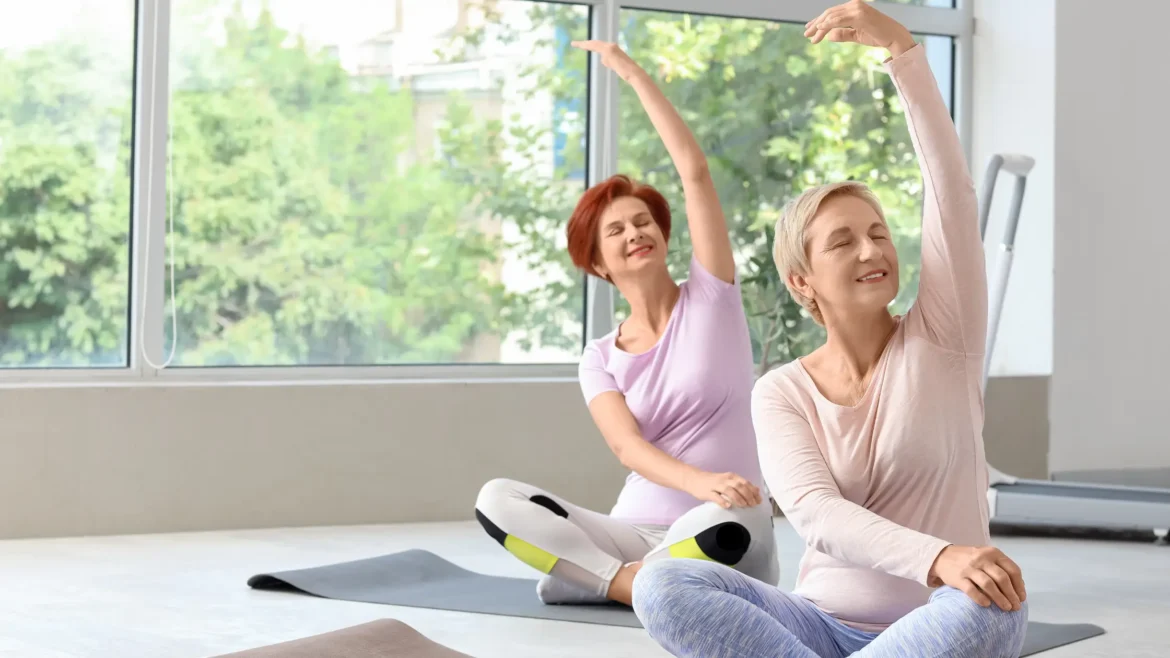Here’s the thing: I was in a downward dog during one of my favourite yoga classes and my foot slipped. I looked over,and yep, the person next to me gave me that sympathetic half-smile. Real talk: it shook my flow. So I decided to try grip socks. And honestly? They changed my practice. No more little slides, no more grabbing the mat mid-pose. They made me feel more connected, more stable, like my feet finally had a good grip. In this guide I’ll walk you through why yogis need grip socks, share six I’ve tried myself (all available on Amazon), and help you pick the right one for your style. We’ll talk open-toe vs full toe, hot yoga vs slow flow, what to look for,and what not to miss. Let’s do this.
Quick Answer Box
- Gaiam Grippy Yoga/Barre Socks – Excellent value, reliable grip for most yoga classes.
- Tavi Aria Yoga Grip Socks – Premium feel, stylish design, great for studio sessions.
- Tucketts Crew Grip Socks – Lightweight, breathable, ideal for hot yoga and sweaty sessions.
Why Yogis Need Grip Socks
Look—yoga mats are great until they aren’t. I’ve had classes where the mat looked fine, but the moment I reached into a standing balance pose my heel slid just a little and I lost my connection. That tiny slip means your muscles engage differently, your alignment gets off, and suddenly you’re fighting the mat instead of flowing with it. Grip socks fix that.
Safety on slick mats is big. Especially if you’re doing vinyasa flows, transitions, or inversions. I attend a studio with shared mats and slick floors—footwear (or socks) with a good grip gives you one less thing to worry about. Hygiene matters too. Bare feet everywhere, sweat, shared space. I prefer socks that give me a barrier so I’m not wondering what foot just walked across my mat.
Better balance in standing poses? Check. I switched to a good pair and during tree pose, I felt more rooted. My instructor even said I had “better grounded energy” (yes, ego fed). And there’s the warmth factor: winter classes in my studio are chilly, and full-coverage grip socks keep toes warm without sacrificing traction. So if you’re serious about your yoga—or just want a more stable, comfortable practice—grip socks are a smart upgrade.
Top 6 Grip Socks Reviewed
Here are six grip socks I personally used this year. I’ll tell you what I loved, what bothered me, and who they’re best for.
1. Gaiam Grippy Yoga/Barre Socks

What makes them special: Great budget option found on Amazon, designed for yoga and barre with non-slip grips.
Pros:
- Solid grip for everyday yoga.
- Lightweight and breathable.
- Affordable, so you can buy multiple colours.
Cons: - Grip pattern not as heavy duty as premium options.
- After many washes the grips flatten a little.
Best for: Beginners, home practice, or folks trying grip socks for the first time.
Price range: ~$7-10 on Amazon.
Personal take: I used these during my home practice. They saved me from a few slips during flowing sequences. But I did notice in a hot yoga class the feeling of the grips was less crisp than my premium pair.
2. Tavi Aria Yoga Grip Socks
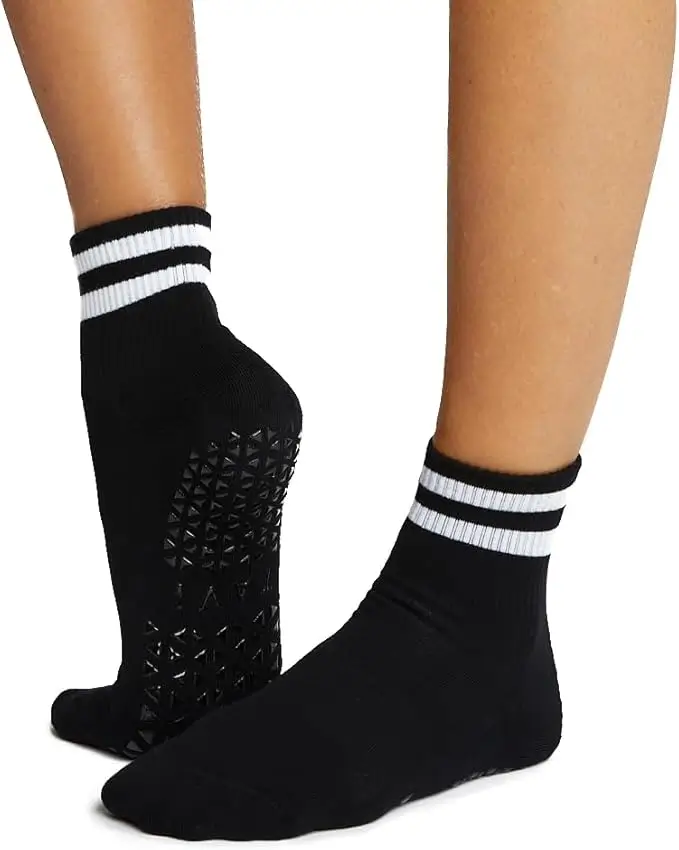
What makes them special: Stylish design plus strong grip—studio-worthy.
Pros:
- Premium look and feel.
- Strong grip underfoot.
- Crew or ankle styles (depending version) give options.
Cons: - Price is higher than budget picks.
- Fit is snug—if you’ve got wider feet you might feel tight.
Best for: Studio regulars who want performance + style.
Price range: ~$20–24.
Personal take: I felt like I was stepping into class with confidence wearing these. The grip held during tricky core flows. Only downside: I felt slightly warmer than my thin socks in a hot yoga session.
3. Tucketts Crew Grip Sock
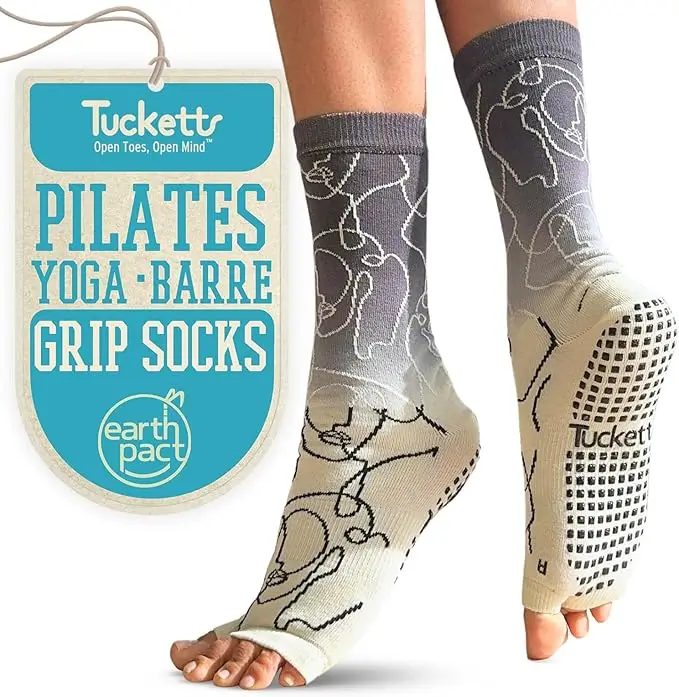
What makes them special: Designed for breathability and sweat—ideal for hot yoga.
Pros:
- Extremely lightweight and airy.
- Good grip when you’re sweating.
- Low-profile design inside the shoe or bootie-style if used.
Cons: - Less padding / cushioning if you prefer that.
- Some versions are open-toe, which not everyone loves.
Best for: Hot yoga, sweaty studios, frequent class goers.
Price range: ~$15–19
Personal take: I took these to a 90-minute Bikram/Hot class. My feet didn’t slip once—huge win. But afterwards I missed the little cushion my thicker socks give for seated poses.
4. Wildarms 4-Pack Pilates/ Yoga Grip Socks
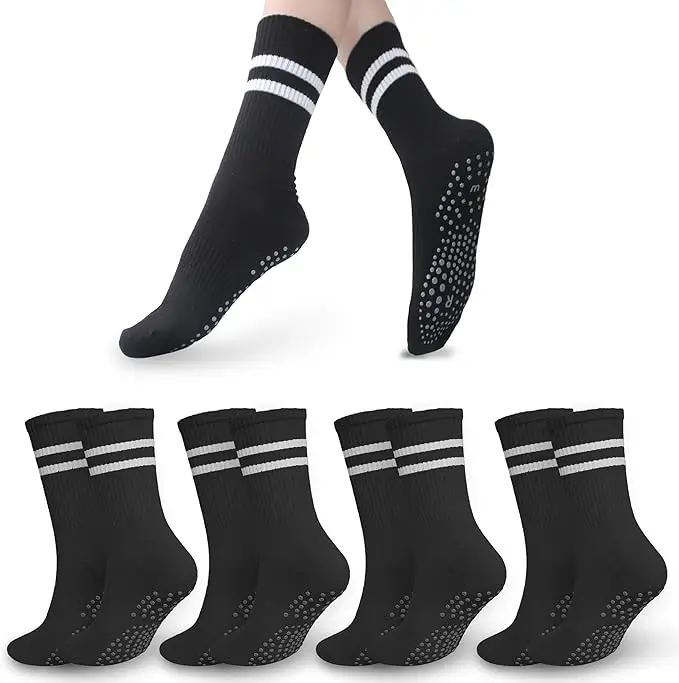
What makes them special: Budget multi-pack—cheap enough to rotate and replace often.
Pros:
- Excellent value for money.
- Good for mat sessions, travel, backups.
- Non-slip grip covers most of sole for basics.
Cons: - Material feels thinner, less plush.
- Grip texture and durability aren’t as strong as premium ones.
Best for: Home practice, casual sessions, travel kit.
Price range: ~$8–12 for pack.
Personal take: I grabbed them when I needed cheap backup pairs. They performed okay in a simple class. But in a fast vinyasa I felt they lacked the “security” of my higher-end pair.
5. Ozaiic Pilates Socks
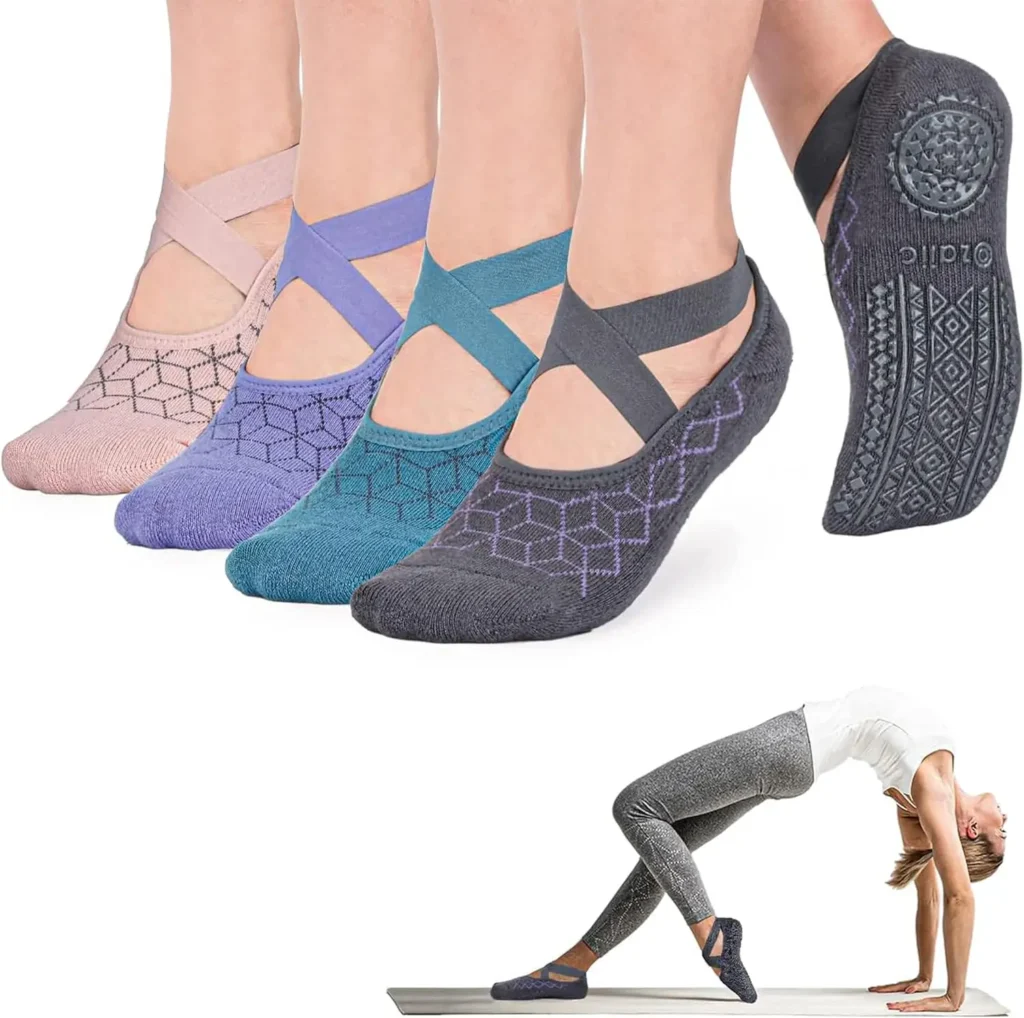
What makes them special: Another budget Amazon set—great for casual use.
Pros:
- Very affordable.
- Decent grip for everyday use.
- Comes in multiple sizes/colours.
Cons: - Durability is weaker—after many washes the grip starts to peel.
- Material is basic—less premium feel.
Best for: Light practitioners, budget-aware folks, beginning classes.
Price range: ~$20–24 for the set.
Personal take: I used one during morning flows. They held up. But I noticed after several uses the grip started to wear—so I flew through the cheap pack faster than I expected.
6. Toesox Open-Toe Grip Socks
What makes them special: Open-toe design for toe freedom—great for balance, sensory feedback.
Pros:
- Allows toes to spread—feels more natural.
- Good grip for steadier poses.
- Light, airy for sweaty feet.
Cons: - Not everyone loves open-toe—some feel exposed.
- Grip area sometimes smaller because of design, so less surface contact.
Best for: Balanced flows, studio use, people who like barefoot feel but want grip.
Price range: ~$15–18.
Personal take: I did a slow vinyasa class with these and loved the toe freedom. I felt connected. But in a rapid flow with quick transitions I did feel a little less “locked-in” vs full-toe options.
Comparison Table
| Product | Grip Strength | Comfort | Toe Style | Price Range | Best For |
|---|---|---|---|---|---|
| Gaiam Grippy Yoga/Barre Socks | ★★★☆☆ | ★★★ | Full-toe | ~$7–10 | Beginners/home practice |
| Tavi Aria Yoga Grip Socks | ★★★★☆ | ★★★★ | Full-toe/crew | ~$20–24 | Studio regulars |
| Tucketts Yoga Grip Socks | ★★★★☆ | ★★★★ | Full-toe/minimal | ~$15–19 | Hot yoga/sweaty classes |
| Wildarms 4-Pack Yoga Grip Socks | ★★★☆☆ | ★★★ | Full-toe | ~$8–12 | Travel / backup / casual use |
| zaiic Pilates Socks | ★★★☆☆ | ★★★ | Full-toe | ~$20–24 | Budget / light practice |
| Toesox Open-Toe Grip Socks | ★★★★☆ | ★★★ | Open-toe | ~$15-18 | Toe-freedom lovers / balance work |
Buying Guide
So, how do you pick the right pair of grip socks for your yoga practice? Here’s what I’ve learned after trying many pairs—let’s break it down casually.
First, open-toe vs closed-toe. If you love that floor-connection, toe-spread feeling—open or half-toe styles (like the Tucketts) give you that barefoot-plus grip sensation. I use those in slow flows where foot placement and balance matter. But if you prefer coverage, warmth, or your studio floor is cold—full-toe is safer and more protective.
Then there’s grip pattern. It’s not just that there are grips—it’s where they are and how many. Socks with full-sole grip (all underfoot) feel way more stable than ones that only have dots under the heel or ball. I noticed the difference during standing balances—when I had only minimal grip I still felt a subtle slip. Material matters too. Cotton is nice—but if you’re in a hot studio or do lots of sweaty flows, synthetic blends wick better and dry faster. My feet used to feel uncomfortable in thin cotton pairs in hot yoga until I switched to a good synthetic one and wow- what a difference.
Fit and sizing—don’t skip this step. Loose socks roll. I had a pair that stretched with washing and mid-class I had to pull them up—annoying. I usually recommend sizing down a notch for grip socks, because snug is better than stretchy. Also check the cuff: crew length gives more coverage (and warmth), ankle styles feel lighter but if you’ve got slim ankles they might slide. If I’m doing a cool studio or winter class I pick crew; for hot yoga/short sessions I go low-rise.
Durability & care. I now look at cost-per-use. A cheap pair that lasts two months vs a premium that goes six to twelve months. If you attend class 3-4 times a week, rotate two pairs so each has time to air-out. Also wash cold, skip fabric softener, and air-dry. I once threw mine in a hot dryer and the grips flattened—very noticeable mid-flow.
Lastly style vs function. Yeah you might want cute straps, fun colours—and that’s okay. But if the grip fails you’ll regret it. I definitely bought a pair just for the look and they sucked in a slippery transition. So choose something that works, then pick the style you love. That’s how you get socks you’ll actually wear.
Yoga Style Recommendations
If you do hot yoga, you’ll want socks that breathe and wick. I prefer a low-rise grip sock with full-sole pattern—my pick: the Tucketts. Less material, more airflow, and good grip when you’re sweating.
For vinyasa flow, lots of transitions and standing poses, I go with a strong grip and full-toe or half-toe depending how connected I want to feel. The Tavi or Tucketts work great here.
In restorative or yin yoga, where poses are slow and grounding is key, comfort and warmth matter more. A full-toe crew grip sock (like one of the budget/flexible pairs) works nicely—less flashy, more snug.
And if you practice at home vs studio, the demands shift. Home practice means you might deal with hardwood floors or bare rooms—not shared equipment—but you still want grip. You might not need the premium studio pair; budget options might suffice. But if you go to a studio often, where mats, equipment, and transitions get faster, invest in one higher quality pair.
Care Tips
To keep your grip socks working: wash them cold, turn inside-out, skip fabric softener, and air-dry. I hang mine on a clip rack so they don’t bunch up. Avoid high heat in dryers—trust me, you’ll feel the difference when you’re slipping mid-lunge because your grips flattened.
FAQ
Can I do hot yoga in grip socks?
Yes! Provided the socks breathe well and have solid grip. In fact I used mine in hot yoga and felt more stable when I was sweaty. Just skip heavy cushioning if it makes your feet too warm.
Do grip socks work on all mat types?
Mostly yes—but slick mats or textured mats vary, so check how the sock feels in your space. I practice on both smooth studio mats and wooden floors—I found grip socks helped more on the smoother surfaces.
Are full-toe socks better than open-toe?
No clear “better”—it depends on feel. Open-toe gives more sensory feedback; full-toe gives more coverage and warmth. I switch depending on class.
How many pairs should I have?
At least two if you go frequently. That way one can dry while you use the other.
Do expensive socks make a big difference?
Often yes. Materials, grip strength & durability tend to be better. But budget options can be good too if you practice less or want backups.
Will grip socks stop me from slipping entirely?
They help a lot—they reduce internal slip, improve foot placement—but they’re not magic. Good form and fit still matter.
Can men use these socks too?
Absolutely—just get the correct size. Many styles are unisex or have men’s sizes.
What if the grip wears out?
Then it’s time to replace. Once you feel even a little slip compared to your new pair, you’ve lost traction and your practice may suffer.
Conclusion
Honestly, switching to good grip socks was one of the best upgrades I made in my yoga practice. I felt grounded, confident, and less distracted by “where are my feet?” moments. If I had to pick one pair to keep forever it would be the Tavi Aria. It just hits that sweet spot of style + performance. But if you’re on a budget, the Gaiam Grippy is a smart start. Whatever you pick—rotate pairs, care for them, wear them consistently—and your practice will feel more secure, more connected, and more you. Here’s to more stable trees, deeper flows, and fewer slips.
**Affiliate Disclosure:** This post contains affiliate links. If you make a purchase through these links, we may earn a commission at no extra cost to you.
